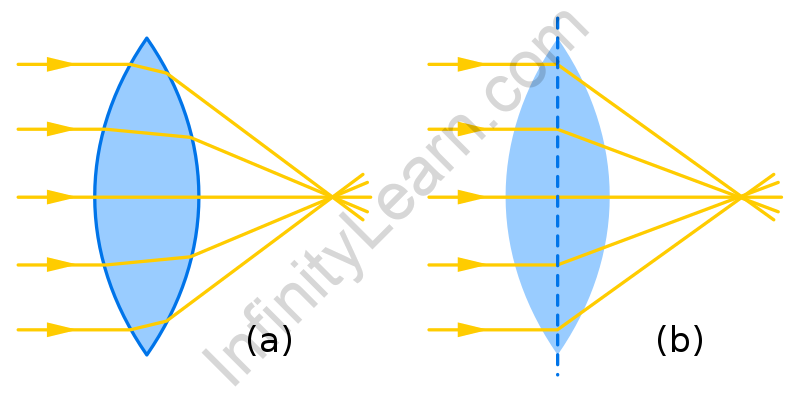Table of Contents
Introduction:
A lens is a transmissive device that focuses or disperses light beams by suggesting refraction. An easy lens consists of one piece of transparent material, whereas compound lenses accommodate many simple lenses organized alongside a standard axis. A lens will focus light to create an image, in contrast to a prism, that refracts light while not focusing.
Compound microscopes and telescopes use convex and concave lenses. Using combos of convex lenses may produce blurred images. This problem has been rectified with the help of a concave eyepiece. Even in cameras now and then a mix of concave and convex lenses are used. The utilization of concave lenses is crucial in lasers. The particular light ray is extremely specific, which can harm instrumentality wherever it’s used (like CDs and scanners). A diverging lens corrects this problem. Furthermore, concave lenses can also be used in flashlights, where the sunlight beam diverges to cover a larger area.
Types Of Lenses
When light rays pass through a lens, the classification of the lens is based on how the rays bend. There are two types of lenses:
- Convex Lens (Converging)
- Concave Lens (Diverging)
Convex lenses are thick within the middle and diluent at the edges. Concave lenses have a flat center and are thicker at the edges. A convex lens is additionally referred to as the converging lens because the light rays bend inwards and converge at some extent that is understood as focal length. On the opposite hand, the concave lens is also known as a diverging lens as a result, it bends the parallel light rays outward and diverges them at the focal point.
Simple and compound lenses are the 2 classifications of lenses. Both the lenses differ from each other based on their surface curvature.
The lens accustomed to building a compound lens could have different refractive indices and alternative properties. The position of lenses is such that they lie on one axis, and properties like focal length are calculated once more for the new compound lens.
Other Lens Types are:
- Cylindrical – curvature in one direction
- Fresnel – narrow ring-like surface
- Lenticular – a group of micro-lenses
- Refractive Index Gradient – surface with different refractive indices on flat surfaces
- Axicon – conical surface
Thin Lenses in Contact:
A simple lens consists of the utilization of only 1 lens. In compound lenses systems, 2 thin lenses are used and kept connected with each other.
Commonly Used Lenses are:
Convex (Converging)
Concave (Diverging)

Compound Lenses
Compound lenses contain 2 thin lenses that are mounted on a standard axis sometimes nearer to every different or typically cemented together.
Formula: The common focal length for a system, wherever two thin lenses sharing an associate degree axis are kept in touch with each other, is given by the subsequent formula.
1/f = 1/f 1 + 1/f 2
where,
The combined focal length is f
The focal length of the first lens is f 1
The focal length of the second lens is f 2
Since the power is that of the reciprocal of the focal length, what’s terribly evident during this case? For thin lenses in touch, it’s pretty clear that the combined power of the system is given by adding the powers of the individual lenses.
However, what if the lenses aren’t in contact with each other? If they are separated by a distance ‘d’, then, in this case, the combined focal length is often calculated mistreatment the subsequent formula
1/f = 1/f 1 + 1/ f 2 – d/f 1.f 2
When the distance of separation between the 2 lenses (d) is up to the addition of the individual focal lengths (f 1 + f 2), the combined focal length is infinite. This makes the refracted light rays parallel to every other.
The lenses used are combined in such a way that two wavelengths (typically the ends red and violet) are brought into focus. This is often one of the applications of using a compound lens system, wherever chromatic aberrations (which can be found in the exploitation of single lenses) are correct.
Application of Compound Lenses
Compound lenses are used in telescopes and microscopes to combine two or more lenses in order to:
- Reducing defects caused by using a single lens.
- Get an erect image of an object.
- Increase the magnification of the image.
FAQs
Question: Why is it necessary to combine lenses?
Answer: A combination of lenses is used in numerous optical instruments because:
- To extend the magnification of the image.
- To extend the sharpness of the image.
- To form the ultimate image erect.
- To minimize bound defects or aberrations within the image shaped by a single lens.
What type of lens is the human eye?
Convex lenses make up the eye's lens. During this process, an image is formed on the retina at the back of the eye. Focusing images of close objects or distant objects is controlled by tiny muscles in the eye.
What is the power of combining lenses?
As a result, the power of a combination of lenses is the algebraic sum of the powers of its individual components. The power of a combination of two lenses is given by a relationship when two lenses are separated by a distance of d metres. P=p1+p2−d⋅(p1⋅p2)









